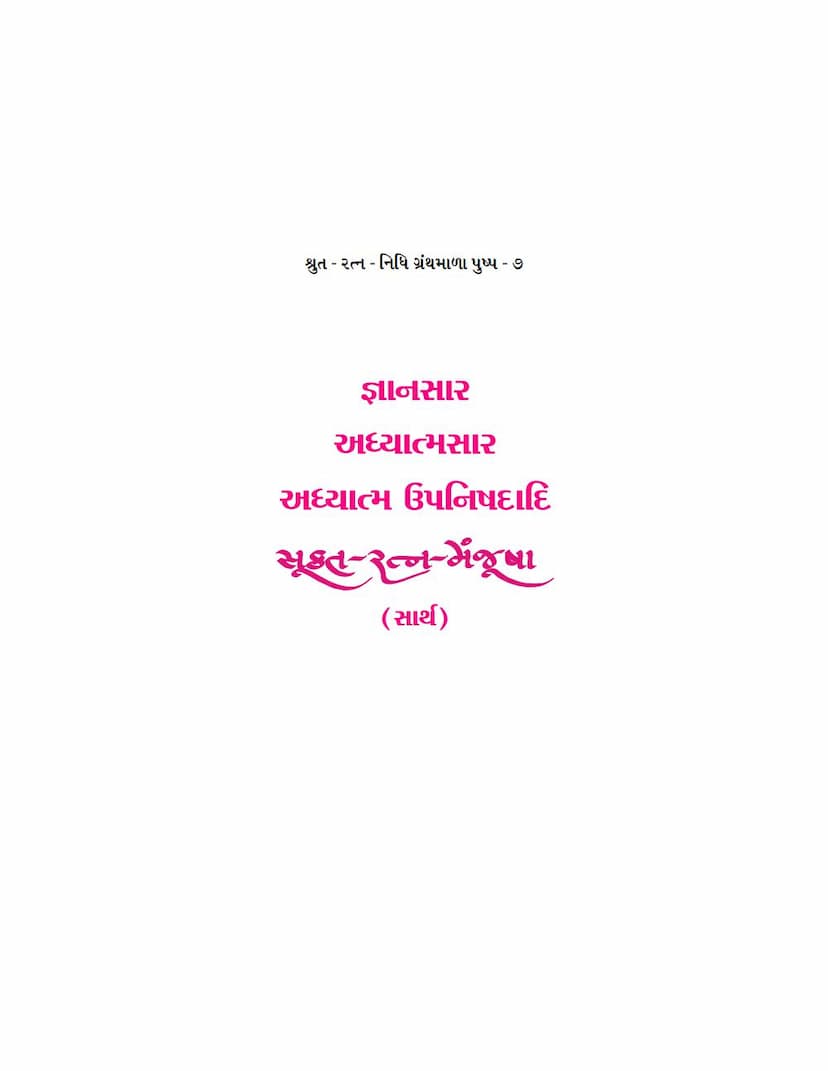Sukta Ratna Manjusha Part 07 Gyansara Adhyatmasara Adhyatma Upnishadadi
Added to library: September 2, 2025

Summary
This document is part of the "Shrut Ratna Nidhi Granthamala" series, specifically the seventh installment. It is titled "Jnansara, Adhyatmasara, Adhyatma Upanishadadi" and edited by Muni Bhavyasundarvijay. The publisher is Shramanopasak Parivar.
The book is dedicated to the Golden Jubilee (50 years) of the spiritual life of Gurudev Acharya Bhagwant Shri Vijay Ratnasundarsurishwarji Maharaj Saheb, described as "Bhavodadhitrata" (Savior from the Ocean of Existence), "Sanyamdata" (Giver of Restraint), "Grahan-Aasevanshiksha Pradata" (Giver of education in acceptance and practice), and "Pravachan Prabhavak" (One who spreads the glory of discourses).
The book aims to make the profound teachings of Jain scriptures, rich in detachment, righteous conduct, spirituality, substance analysis, self-focused contemplation, soul's development, and the principles of Yoga and spirituality, accessible. It acknowledges the great service done by ancient sages in encapsulating these teachings in Prakrit gathas and Sanskrit shlokas.
The introductory sections highlight the tradition of memorizing gathas, dating back to Lord Mahavir's time. Examples are given of eminent monks who had vast memorization capabilities (e.g., Bappabhatt Suri memorizing 1000 gathas daily, Acharya Atmaramji memorizing 300 gathas daily). It also notes a decline in this practice among both monks and lay followers in current times.
The primary reason cited for this decline is the sheer volume of original texts. To address this, the book presents a compilation of selected, essential, and impactful gathas from various significant Jain texts. This compilation is undertaken with the intention of promoting the memorization and understanding of these verses, thereby fostering spiritual growth and progress towards liberation.
The editor, Muni Bhavyasundarvijay, is praised for his discerning selection of gathas, choosing those that are impactful and useful, and for the immense effort involved in this task. The hope is that these smaller booklets will reignite the practice of memorizing gathas within the Jain community.
The editor's note further elaborates on the vastness of Jain scripture and the challenge of memorization due to the current era's impact on memory. It explains that this publication is a condensed form of these vast texts, providing the essence of specific detached and spiritual verses with their meanings. This practice of summarizing ancient texts is not new, with previous scholars having created condensed versions of works like Upamiti, Kuvalayamala, Trishashti, and others. The editor assures that these condensed versions do not diminish the importance or availability of the original texts.
The selection of gathas focuses on their ability to generate detachment and other positive spiritual states, their diversity, ease of memorization, and clarity of meaning. The gathas are arranged thematically rather than strictly by their original order in the texts. The publication also aims to facilitate the regular recitation and retention of these verses to cultivate spiritual sentiments and accelerate the path to liberation.
The book is structured into sections covering various philosophical and ethical aspects of Jainism, drawing from the works of Mahopadhyaya Shri Yashovijayji Maharaj. The content is divided into:
- Jnanasara: This section focuses on various aspects related to knowledge, including the nature of knowledge, its distinction from ignorance, the qualities of a wise person, the attainment of knowledge, and the practice of equanimity and detachment. It emphasizes that true knowledge leads to inner peace and liberation from suffering.
- Adhyatmasara: This section delves into the essence of spirituality, discussing the importance of the soul, the nature of the self, the path to liberation through right knowledge, conduct, and penance. It highlights the significance of detachment from worldly pleasures, control over the senses, and the practice of meditation.
- Adhyatma Upanishadadi: This section draws from texts like Adhyatmoppanishad, Vairagya Kalpalata, and Margaparishuddhi. It further elaborates on spiritual practices, the importance of equanimity (samata), the fruits of detachment (vairagya), the path of right conduct (margaparishuddhi), the guru-disciple relationship, and the ultimate goal of liberation.
Throughout the text, there are numerous Sanskrit shlokas (verses) followed by their Gujarati translations, explaining complex philosophical concepts in an accessible manner. The book uses a systematic numbering system for the verses, referencing the original text and the chapter/verse number.
In essence, the book is a valuable resource for Jain scholars and practitioners, providing a curated collection of essential verses to aid in the study, memorization, and internalization of Jain spiritual wisdom, thereby promoting spiritual progress.